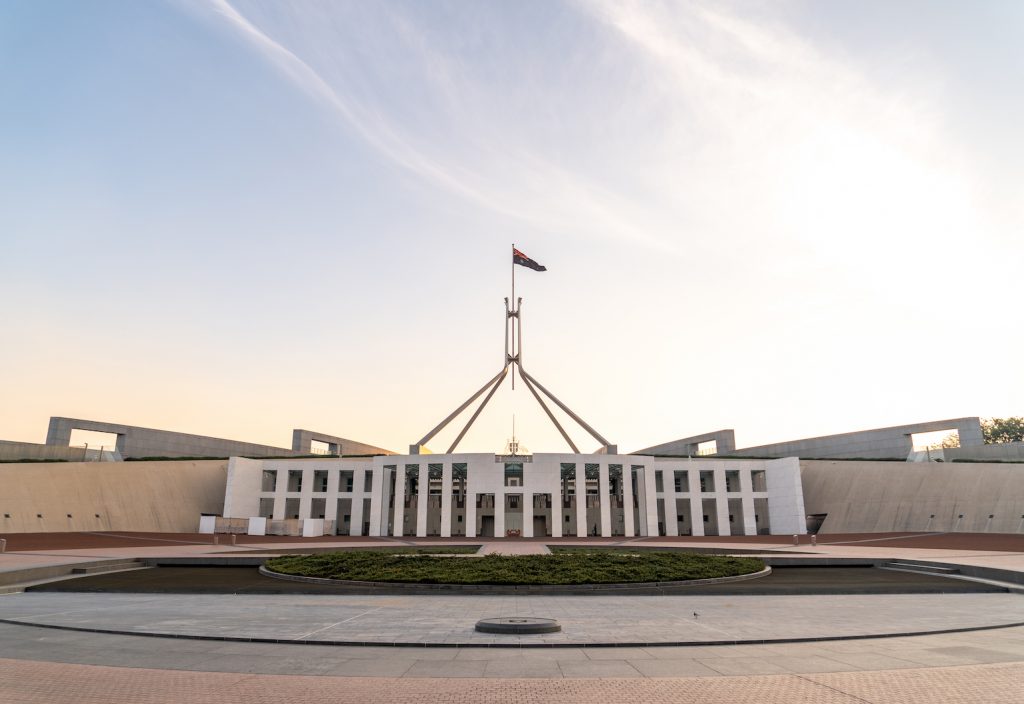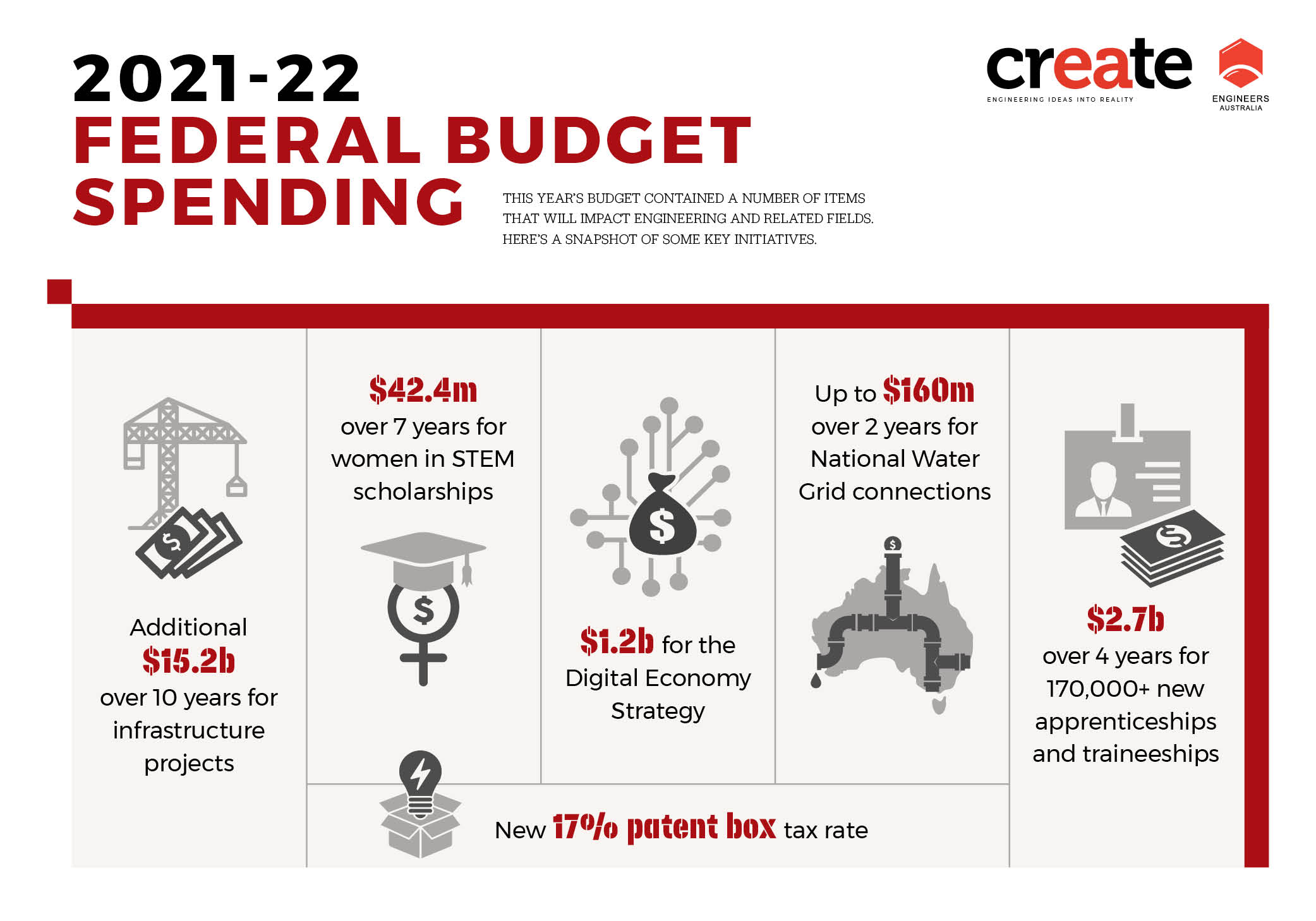Australia’s economic engine is “roaring back to life”, Treasurer Josh Frydenberg told the nation on Tuesday night, as he delivered a Federal Budget focused on recovery and rebuilding.
The 2021-22 Budget “secures the recovery and sets Australia up for the future”, Frydenberg said, to “ensure we come back even stronger” following the COVID-19 pandemic.
Engineers Australia CEO Dr Bronwyn Evans HonFIEAust CPEng said engineers have a vital role to play in nation building, and that the next phase of Australia’s economic recovery should include upskilling and reskilling the workforce in areas such as energy and advanced manufacturing.
The Budget includes an additional $500 million to expand the JobTrainer fund and extend the program until 31 December 2022. The government will also invest $7.6 million to extend the National Careers Institute to ensure young people are better connected with education, training and work options.
Digital skills will also be addressed, with more than $100 million to build technical competency and $124.1 million for research into the development of artificial intelligence.
With Australia’s closed borders contributing to skilled labour shortages, the government aims to fill the gap with domestic training programs and by providing new avenues for skilled migration.
Although Engineers Australia supports the focus on skills programs, Dr Evans said it is also important to harness the skills of migrant engineers who are already in Australia.
“A great many migrants with engineering degrees in Australia have not been able to work in their profession due to a range of largely systemic barriers,” she said.
“With borders closed, a focus on supporting those who struggle to enter the local workforce would have enabled greater efficiency in workforce utilisation.”
Infrastructure
The government is focused on “building the infrastructure our economy needs for the future”, and will provide an additional $15.2 billion to fund road, rail and community infrastructure projects over the next decade.
This is estimated to support 30,000 jobs across Australia and will take the government’s total infrastructure spend to $110 billion over 10 years.
Some of the big-ticket transport projects that will receive funding include:
- $2 billion to support the delivery of the Melbourne Intermodal Terminal
- $2.6 billion for the North-South Corridor in South Australia
- $2 billion for the Great Western Highway in New South Wales
- $400 million for Queensland’s Bruce Highway
- $379 million for Perth’s transport and land use initiative, METRONET
- $150 million for highway upgrades in the Northern Territory
- $132.5 million for stage 2a of Canberra’s light rail project
- $113.4 million for the Midland Highway in Tasmania
The Budget also features an additional $1 billion in road safety upgrades and a further $1 billion for local road and community infrastructure projects.
“While funding and support for critical infrastructure is applauded, it will be essential that engineering expertise is engaged in project procurement, planning, design, delivery, implementation and beyond,” Dr Evans said.
Engineering expertise and solutions could also be used to better connect Australia’s urban and regional communities, Dr Evans said, with improvements in telecommunications, transport and digital infrastructure vital for the nation.
Technology and industry
Australian manufacturers “stepped up to meet the challenge of the COVID-19 pandemic”, the government said, with many pivoting their businesses to produce personal protective equipment (PPE), ventilators and hand sanitisers that were central to Australia’s health response.
For example, the government pointed to Victoria’s Shepparton-based Med-Con, Australia’s only medical mask manufacturer, which boosted its production capacity from two million to more than 90 million surgical masks in 2020.
Last year, the government committed $1.5 billion to a 10-year Modern Manufacturing Strategy, which it said would help make Australian manufacturers more competitive, resilient and able to scale up.
“One of the key realisations for the government during COVID-19 has been the importance of diversifying the economy and securing supply lines,” Dr Evans said.
She said the manufacturing strategy was “an encouraging step in the right direction, which seeks to bolster our domestic manufacturing sector and is important signalling for engineering firms”.
The manufacturing sector continues to be “a key driver of future jobs and higher wages,” Frydenberg said. As such, the government is eager to see more innovation commercialised in Australia, and has announced a new ‘patent box’, launching on 1 July 2022.
Under the patent box, income earned from new patents developed in Australia will be taxed at a concessional rate of 17 per cent rate. This will initially apply to the medical and biotech sectors, and the government will consult on expanding it to the clean energy sector.
The government will also attempt to shore up Australia’s supply chains with a $107.2 million Supply Chain Resilience Initiative, which will examine vulnerable, essential and critical products, beginning with common medicines, PPE and agricultural production chemicals. It will deliver grants to businesses to address critical supply chain vulnerabilities from July this year.
Other initiatives include:
- an additional $13.3 million over four years for the Australian Space Agency
- $387.2 million over 10 years to build a Square Kilometre Array telescope in Western Australia, including $54.2 million to establish a supercomputing centre in Perth to process the vast amount of data that will be generated
Energy
The government is promoting a “gas-fired recovery” out of the pandemic, with new funding of $58.6 million over four years to “support key gas infrastructure projects, unlock new gas supply and empower gas customers”.
It is also supporting local oil refineries as part of a “commitment to jobs and Australia’s long-term fuel security”.
There was no new direct funding for renewable energy in the Budget, apart from $30 million over the next year for a big battery and microgrid project in the Northern Territory.
Instead, energy spending is mostly focused on low emissions technologies, including $1.2 billion over 10 years to establish Australia as a leader in the field. This includes $275.5 million to develop four hydrogen production hubs in regional areas and $263.7 million for carbon capture technologies.
Dr Evans said “low-cost, reliable clean energy should be the goal” of Australia’s energy policy, and that the challenge was to “manage the integration of renewables to come on line at scale as needed”.
Engineers have a vital role to play in this, Dr Evans said, as they can provide the technical expertise needed to solve the problems that come with such fundamental change.
“The government should take an active role in shaping outcomes through smart policy settings outlined in a comprehensive energy transition plan,” she said.
Notably absent from the Budget was a focus on the power system. As Australia’s power network evolves, with the growth in renewables and customer-owned generation, the system must be planned, analysed, designed and operated as an engineering system.
Women in STEM
The government will spend $3.4 billion over the next five years to improve outcomes for women.
It will also invest $1.7 billion over five years in an attempt to increase the affordability of childcare for low– and middle-income families. From July 2022, families with two or more children under five will receive subsidies of up to 95 per cent of their childcare costs for their second child.
The government said this would give more parents, especially women, the choice to take on extra work.
Women make up just 14 per cent of the engineering workforce, and have been shown to drop out of the profession at crucial moments in their careers — known as the ‘leaky pipeline’.
“Delivering a childcare system that allows parents, particularly women, to return to work is imperative to ensure we improve gender diversity across all workplaces,” Dr Evans said.
The government will also invest in initiatives designed to improve women’s workforce participation, including $42.4 million over seven years to support more than 230 women to pursue higher level STEM qualifications. This builds on last year’s budget, which included $240 million in measures to support new cadetships and apprenticeships for women in STEM, as well as to support women’s safety at work and home, and promote job creation and entrepreneurialism.

